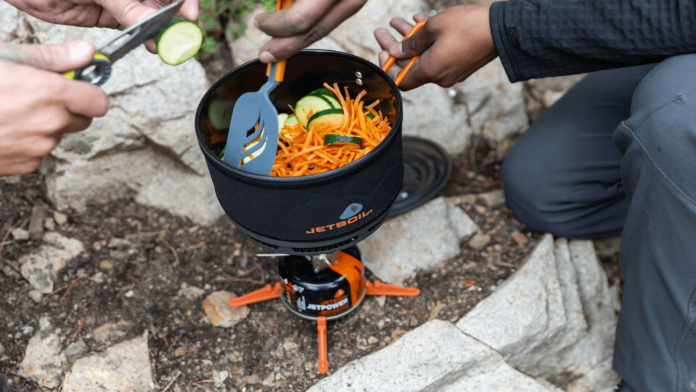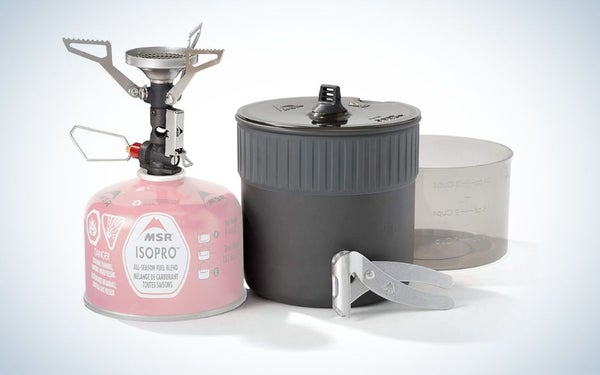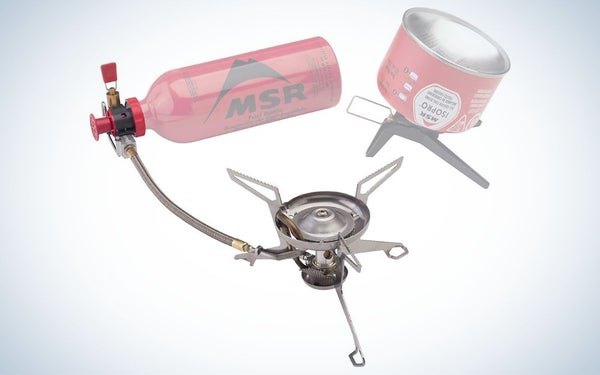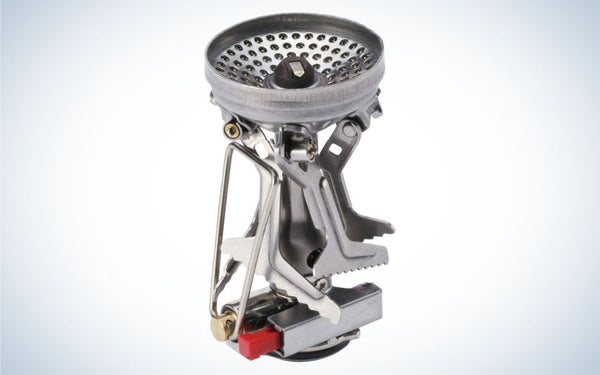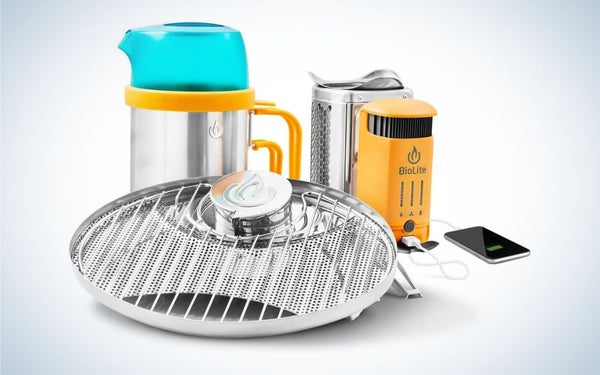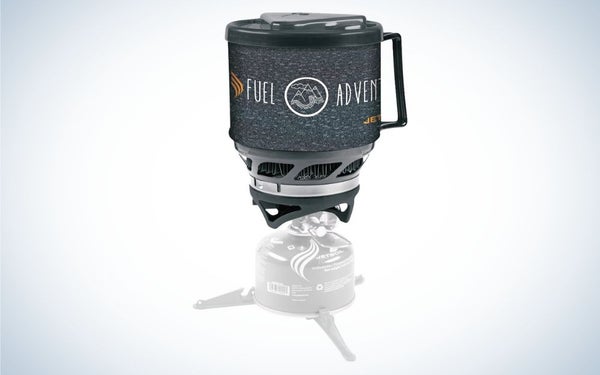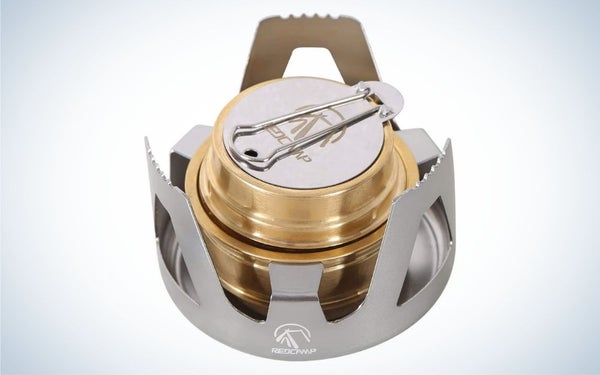We may earn revenue from the products available on this page and participate in affiliate programs. Learn more ›
Updated Feb 13, 2023 9:35 PM
Choosing a backpacking stove is as simple as understanding the different options and your intended use. Backpacking stoves differ from larger camp stoves because they are more portable and have a smaller cook space.
While our thoughts may shift to the classic propane stove options, other fuel varieties may be better suited for your backcountry needs. The best backpacking stoves are the ones that work for you, are easy to pack, and have ample durability to be used outdoors for years to come.
All boil times listed in product descriptions are for 1 liter of water.
How We Chose The Best Backpacking Stoves
Although there are various stove fuel options on the market, we chose to focus on propane stove options with a few others mixed into the review. Because most consumers are used to using those stoves, it makes sense that a significant focus is put on that area. However, there are many other fantastic fuel options that are likely more sustainable and longer lasting than some propane stove options.
Along with the buying considerations explained in this article, we chose the best backpacking stoves using the following criteria:
- Longevity: The durability and lifespan of a product should always be a top priority. Beyond that, we look at repairability and company repair policies.
- Functionality: No single stove is likely to fit everyone’s needs, so choosing stoves that provide the most functions was a priority. A lean toward propane stoves is partially for customer convenience and ease of use.
- Sustainability: Using a propane stove is never the most sustainable option, especially using single-use canisters. Within the review, we included more sustainable options such as liquid fuel and wood-burning stoves.
- Customer Service: A company’s response to customers is always considered when writing reviews. How does the company respond if a customer has a question or issue with a product?
Other factors played into our decisions, including personal experience with gear, verified customer testimonials, and company-specific product research.
The Best Backpacking Stoves: Reviews & Recommendations
Best Overall: MSR Pocket Rocket Deluxe
Why It Made the Cut: The MSR Pocket Rocket Deluxe is a dependable and compact stove with quick boil time and simmering capabilities.
Key Features
- Weight: 2.9 ounces
- Fuel Type: Isobutane/propane canister
- Average Boil Time: 3.5 minutes
Pros
- Lightweight compact design
- Simmer doesn’t burn food while cooking
- Easy to use
- Built in pressure regulator
- Works well in the wind
Cons
- Piezo ignitor is somewhat unreliable
MSR has a wide range of fantastic backpacking stove options, and we had a hard time choosing between the PocketRocket 2 and the PocketRocket Deluxe. Ultimately, we landed on the MSR PocketRocket Deluxe because of its superior performance in windy conditions. It’s slightly heavier than the PocketRocket 2 but is still relatively lightweight and compact, making it easy to pack along on any trip.
Working with isobutane/propane canisters, it is easy to use and understand for most campers. Although there is a piezo ignitor to make things a little easier, it is somewhat unreliable. Regardless of that minor flaw, the wider cook space helps with the stove simmering capabilities, preventing food from burning.
Since most campers are worried about boil times, the Deluxe can reach a rolling boil in 3-3.5 minutes, even in cold weather and with low fuel. We also like that MSR has nestable cooking kits, making backcountry cooking even easier.
Best Wood-Burning: Solo Stove Lite
Why It Made the Cut: The Solo Stove Lite is a lightweight and efficient wood-burning stove, providing a practical alternative to propane canisters.
Key Features
- Weight: 9 ounces
- Fuel Type: Wood or alcohol
- Average Boil Time: 8-10 minutes
Pros
- Lightweight
- Versatile fuel options
- Durable stainless steel
- Virtually smokeless fires
Cons
- Takes more attention to keep the fire burning hot as you cook
- No simmer control
The innovative Solo Stove design has been shrunk down into a backpacking-friendly package. Still offering a double wall design with optimal airflow and reducing smoke, the Solo Stove Lite is a versatile and lightweight stove option.
Any wood-burning camp stove requires more attention than classic canister stoves that you can light and let boil. Still, with the right hardwood fuel or fuel pellets, the 8-10 minute boil time doesn’t need much upkeep. The windscreen helps lower the boil time and keep it more consistent. It takes a little getting used to, but once you know where the internal fire needs to be at its hottest, it becomes much easier to manage for cooking.
If you want a more consistent flame and less stress of collecting twigs that fit in the stove, the Solo Stove Lite can also be paired with an Alcohol Burner. Having one stove that uses two different fuel options makes it a bit more versatile and can ensure you never run out of fuel on the trail. Regardless of the fuel type, we recommend wearing heat-resistant gloves to protect your hands as you cook and add fuel to the stove.
Best Liquid Fuel: MSR WhisperLite Universal
Why It Made the Cut: The MSR WhisperLite Universal stove is ideal for international and cold weather travel with versatile and affordable fuel options.
Key Features
- Weight: 13.7 ounces
- Fuel Type: Canister fuel, white gas, kerosene, or unleaded gasoline
- Average Boil Time: 3.5 minutes (white gas)
Pros
- Reusable fuel container
- Ideal for cold weather and high elevation
- Very versatile
- Excellent simmer control
Cons
- Heavier than other options
- Requires more maintenance than canister stoves
If you need a four-season stove that’s also reliable for international travel, consider a liquid fuel stove. Even if you are only into car camping and the occasional overnight trip, liquid fuel is a reliable and more sustainable option than canister stoves. The MSR WhisperLite Universal stove has a similar water boiling time to other MSR stoves but also tends to have better simmer control.
Although this liquid fuel stove works very well with fuel like white gas, it is also compatible with propane canisters when necessary. Overall, purchasing white gas is very affordable and lasts a long time.
If you are used to canister stoves, there can be a learning curve when learning how to use and maintain a liquid fuel stove, but we feel it is well worth it. This stove can do everything from boiling water for backpacking meals to making pancakes for a gourmet camp breakfast. A wind guard can be purchased separately, which is recommended especially for backpacking trips.
Best Lightweight: Soto Amicus
Why It Made the Cut: The Soto Amicus stove is a highly functional ultralight stove option at an affordable price.
Key Features
- Weight: 2.79 ounces
- Fuel Type: Isobutane/propane canister
- Average Boil Time: 3 minutes
Pros
- Great value
- Lightweight and packable
- Durable materials
- Quick to boil even in wind
- Fuel-efficient
Cons
- Loud burner
- Not the most stable
The Soto Amicus is a great choice if you are looking for an ultralight canister stove. For even lighter stoves, look at alcohol or solid fuel stoves. These can be effective, light, and compact but will take longer to reach a boil. You can also consider going stoveless, eating dry and cold soak foods, for a true ultralight journey.
Even though it is a lightweight option, the Soto Amicus is an excellent value. The stove price is great, but if you invest in your first backpacking stove, they also have a very affordable cookset combo that includes a pot. The pot within the cookset isn’t the highest quality but works well with the stove. The pot isn’t necessarily that lightweight either, so if you want a genuinely ultralight setup, you may want a different pot option.
The stove is very effective and works well in the wind. The burner is slightly receded to help protect the flame from the wind, so even without a wind guard, this stove has minimal issue boiling water. The MSR PocketRocket 2 is similar in weight and price but isn’t as reliable in the wind without a guard. Either stove is an excellent option for a lightweight backpacking stove.
Best Cooking Kit: BioLite CampStove Complete Cook Kit
Why It Made the Cut: The BioLite CampStove Complete Cook Set is a complex yet efficient wood-burning camp stove that offers more than just cooking capabilities.
Key Features
- Weight: 2 lbs (no grill)
- Fuel Type: Wood pellets, sticks
- Average Boil Time: 5 minutes
Pros
- Turns fire into electricity
- Don’t need to carry fuel as you hike
- Integrated light and coffee press
- Set nests together
Cons
- Heavy
- Price
- Longer boil time than other options
The BioLite CampStove Complete Cookset is a unique camp cooking option. Although the complete cookset isn’t ideal for backpacking, if you leave the portable grill attachment at home, it can function as a backpacking stove.
It will still be one of the heaviest options on our list, but keep in mind that it is more than just a cook stove. One of BioLite’s biggest selling points is that it turns fire into electricity. The CampStove 2 creates 3 watts of electricity as your fire burns to charge your devices as you cook or for later use within the 2600mAh portable battery.
Even without the grill (which is terrific for car camping adventures), you have the option to carry no fuel, which can offset the weight some. Gather sticks, pinecones, and leaves for cooking your food. Read through the full instructions and test the stove at home before your trip. It is a bit different than using a standard canister stove, and getting the boil time down to 4 to 5 minutes requires a hot fire. If the LED dashboard shows the fire’s heat at about halfway, it will take closer to 10 minutes to reach a boil, so getting the fire hot and using the light panel as a reference is helpful.
Best Canister Stove: Jetboil MiniMo Cooking System
Why It Made the Cut: The Jetboil MiniMo is a compact canister cooking system that not only boils water faster but has struck a decent balance with a simmer setting.
Key Features
- Weight: 13 ounces
- Fuel Type: Isobutane/propane canister
- Average Boil Time: 4 minutes
Pros
- Small and compact system
- Fast boil time
- Very fuel-efficient
- Piezoelectric igniter
Cons
- Less efficient boil time in even light wind
Any Jetboil stove could’ve made the cut for the best canister stove, but the Jetboil MiniMo Cooking System is one of the brand’s best lightweight options. With a capacity of 13 ounces of water, reaching a boil takes about 2 minutes. Compared to the other Jetboil stove options, the MiniMo has a re-proportioned cooking cup design and new valve technology that helps improve simmering capabilities and the shorter and wider canister makes eating easier.
If you rely on dehydrated, pre-packaged, or very simple meals in the backcountry, the MiniMo is a top-tier option. It excels at boiling water and can tackle light simmering, but it isn’t a versatile cooking stove. Packability and functionality (works down to temperatures as low as 20 degrees F) set it apart from other Jetboil designs.
Best Budget: Redcamp Mini Alcohol Stove
Why It Made the Cut: The Redcamp Mni Alcohol Stove is an effective camp stove that is affordable and easy to pack.
Key Features
- Weight: 5 ounces
- Fuel Type: Denatured alcohol/methylated spirits
- Average Boil Time: 7-12 minutes
Pros
- Affordable price
- Lightweight and packable
- Relatively wind resistant
Cons
- Not the most stable base for pots
- Slower boil time compared to other options
If price is your biggest hurdle in getting a camp stove, we always recommend asking friends or looking for used options. Alcohol stoves are also an affordable option, which is why we chose the Redcamp Mini Alcohol Stove as the best budget option.
Integrated with a stove stand and windscreen, the brass alcohol stove gets the job done. Fuel for these stoves is available almost anywhere, but finding a container to carry it in while you hike can be more of an issue. For any stove like this, you can’t store the fuel inside the canister—you’ll need a separate container or it will leak.
It’s a simple design that is easy to use. The only downside to any alcohol stove is that it takes longer to reach a boil, and you cannot control the flame, making simmering more challenging. As a budget stove, this one is safe and effective for any backpacking trip.
Things to Consider Before Buying The Best Backpacking Stoves
Before any purchase, knowing all the options and which ones best fit your backpacking needs is helpful. A wide variety of backpacking stoves are available, all with unique pros and cons. By evaluating the considerations described below, you help avoid impulse buys and have a higher likelihood of investing in a product you can enjoy for years.
Intended Use
Backpacking stoves need to be packable and portable. For car camping or RVing, having a larger stove or camp griddle may be more suitable and can give you more room to cook gourmet camp meals.
Weights and sizes will vary according to the stove type and brand, so other considerations regarding intended use include:
- Group size
- Types of meals you’re preparing
- Climate
- Fire restrictions in the area
How comfortable you are with that fuel type may also matter within this category. If you are unfamiliar with wood-burning or alcohol stoves but have previously used canister stoves, it may be a big jump to try one of the other options. Opting for a more sustainable and easier-to-use option within propane stoves is still possible with refillable canisters or liquid fuel stoves that work similarly to classic propane stoves.
Stove Type
Several types of backpacking stoves are available, but we will overview a few of the most commonly used ones.
- Canister: Fueled by isobutane or propane, these are the easiest to use and lowest maintenance stove options. The stove is small and screws into the top of the fuel canister. Fuel canisters come in various sizes and can be either single-use or refillable. Fuel canisters can be difficult to dispose of properly, so learn how to safely do so before using them.
- Liquid Fuel: A more versatile option than canister stoves, liquid fuel stoves come with a refillable bottle. They primarily run on white gas, but some other fuel options exist (usually internationally). Liquid fuel tends to be a more reliable option at higher altitudes or in extremely cold conditions, and with a reusable container, you have less waste in the long run. Liquid fuel stoves require a bit more during use due to the priming and occasional maintenance, like cleaning the fuel hose.
- Alcohol: Popular among ultralight backpackers, alcohol stoves generally only weigh 1 to 2 ounces. Fueled by denatured alcohol tablets—which are affordable and easy to find in the United States—they’re great if you only need to boil water, although they generally require more fuel to reach a boiling point. Alcohol stoves are inexpensive and lightweight but not the most efficient. These are excellent options for survival kits.
- Wood-Burning: Using wood pellets, twigs, leaves, and other materials found in the forest, these stoves do not require carrying fuel as you hike. They can be a lightweight and efficient option for outdoor cooking, especially since most of them provide a contained smokeless fire. Unless you carry pellets for the stove, be aware that if fuel is wet, the stove will struggle to function. Additionally, these stoves cannot be used in areas with a burn ban. Most of these stoves are lightweight and packable, and some can even charge an external battery.
- Solid Fuel: Not to be confused with an alcohol stove, solid fuel stoves are very small and compact stoves that run off small fuel tablets. They are popular among ultralight backpackers and are used primarily to boil water. The tablets can be extinguished and used again, but they can have a slight odor or even leave some residue on your cooking pot. Solid fuel stoves work best for folks that want a cheap option that is small and compact or as a backup in a survival kit.
When choosing between the different fuel types, beyond your comfortability using that type of fuel, it is helpful to look at product specifications like the average boil time, fuel burn time, the weight of fuel, and convenience. All of those aspects will impact your cooking experience. Larger stoves for car camping will also differ but may have some overlap with fuel types. See our list of the best camping stoves.
Cooking Capabilities and Features
Other than fuel type, the stove mechanism and how it fits your cooking needs is important. Look at the stove’s stability when it is placed on the ground. Are there stabilizers of any kind, or is it relying on the canister to hold the stove? Some stoves have stabilizers that can be purchased separately.
Next, consider how you light the stove. Do you need a lighter, or is a piezo-igniter built into the stove? For alternate fuel stoves like wood or alcohol, matches or a lighter is always required.
The cooking capabilities of a stove are often broken down into the average boil time and if there are simmering capabilities. Boil times vary between brands and models, but other factors like wind can play a role. Some stoves come with a wind guard, while others need to have one purchased separately.
Integrated canister stove systems (like Jetboil) across the board have the fastest boil times but are limited when it comes to simmering. Canister stoves, in general, also boil water quickly but are more versatile because they can simmer more effectively. Simmering isn’t necessary for pre-packaged backpacking meals, but for gourmet camp cooking, having a simmer setting is a must. Liquid fuel stoves also boil water quickly and have simmering options. Liquid fuel boils water fastest in cold conditions and is recommended for high-altitude cooking.
All alternate fuel stoves (alcohol, solid fuel, and wood) are capable of boiling, but not all will be great with simmering. Stoves like the BioLite wood-burning stove may be a better option for simmering and grilling as it has a heat reading light on the LED dashboard. Across the board, though, alternate fuel stoves will be the slowest at boiling water.
The last feature to look for on any stove is the burn time. How long does the stove burn on a set amount of fuel? These are essential considerations to ensure you do not run out of fuel while on a trip. With wood-burning stoves, you do not need to worry as much, but it is good to know how much wood is required to cook a meal.
FAQs
Q: What is the most efficient backpacking stove?
If we count efficiency in terms of boil time, then a stove like the Jetboil Flash is an excellent option. The most efficient stove, in general, should reflect your specific camp cooking needs. For instance, a stove that can boil water fast isn’t necessarily the best stove for cooking a gourmet camp breakfast for the family.
Q: Are backpacking stoves worth it?
For most people, backpacking stoves are worth it, especially if you enjoy a warm breakfast or dinner. Others are content heading into the backcountry and eating dry or cold foods the entire time. That route tends to be more popular for ultralight hikers and long distance runners but is not uncommon.
Q: What is the lightest backpacking stove?
The White Box Next Generation Alcohol Stove may be the lightest backpacking stove currently available. This alcohol stove weighs just 1 ounce. It runs off of denatured alcohol or methyl alcohol (HEET in the yellow bottle) and can hold around 2 ounces of fuel. There are many lightweight options for every stove fuel type, but alcohol stoves are generally the lightest.
Q: How do I choose a backpacking stove?
The easiest way to choose a backpacking stove is to evaluate your intended use and personal preferences for meals in the backcountry. Going from there, use the buying considerations described above to help you narrow down your choices and choose the best backpacking stove for your needs.
Q: How long does it take to boil water with a backpacking stove?
How long it takes to boil water with a backpacking stove depends on the fuel type, stove power, and other environmental factors. Stoves like the Jetboil Flash are said to bring water to a boil in as little as 100 seconds, and other popular stove brands like MSR can usually boil water in around 2 minutes. Most backpacking stoves on the market should be able to boil 1 liter of water in under 10 minutes, but most will be closer to 5 minutes or less.
Q: Can you fly with a backpacking stove?
You can fly with backpacking stoves, but they are only allowed in carry-on or checked bags if they are empty of all fuel and cleaned of fuel vapors and residue. Fuel is not allowed, but the stove mechanism should be; it is always advised that you research the individual airline policies to ensure it is permitted.
Final Thoughts on the Best Backpacking Stoves
The best backpacking stove is the one that works for you and your backcountry needs. We don’t all need to break the bank to get the lightest, fastest boiling stove just so long as it works to our standards. Having a hot meal on a backpacking trip isn’t necessary, but it can enhance the trip and add an extra layer of comfort to life outdoors.

